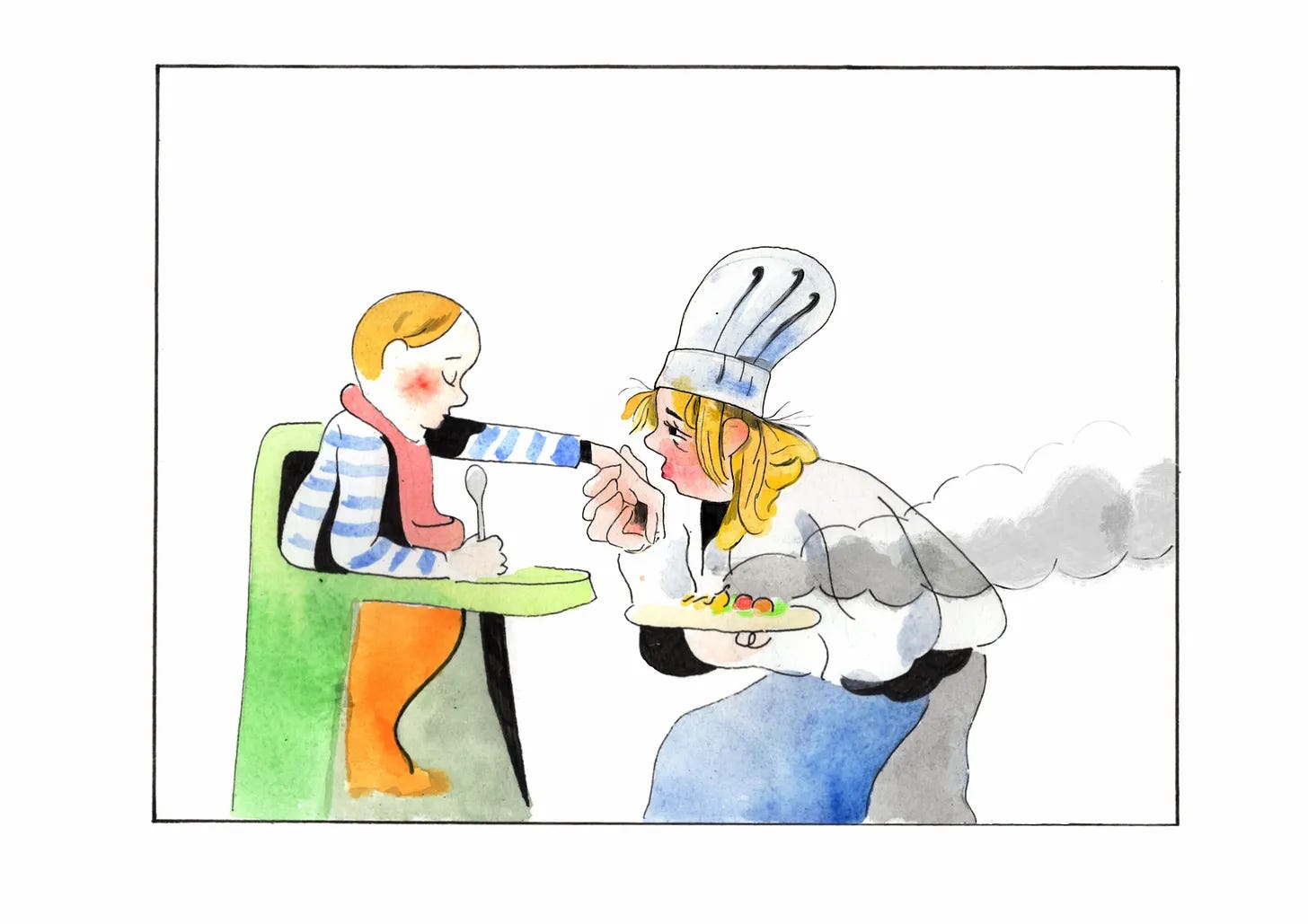“It is my job, we are both aware, to adore and mollify you”
In this edition of the Weekender: mod medievalism, writing for posterity, and a stop-motion skateboard

This week, we’re trying long distance, revisiting Middle Earth, eating “fried balls,” and bidding a fond farewell to spring.
TRAVEL
Space and time
Madison Huizinga considers different ways of measuring a long-distance relationship.
Times Moves Differently on Holiday
—
inI’ve always been better at estimating time than distance. I always know how long it’ll take me to get ready, how long it’ll take to commute to a familiar location at a familiar time of day. If you want to eat at 7:30, I know when I should begin peeling the onions. I have made accurate guesses of how long relationships will last, of how long it’ll take me to finish a book. I feel very confident in my assessment of a minute, or fifteen, or thirty.
Distance, on the other hand, is a mystery. If you ask me how many miles there are between two cities, I’ll draw a blank. When I was living in New York, I met a girl from Minnesota and told her it must be nice not to be so far from home, to which she nodded her head slowly and uncertainly. When I was little, I thought that planes remained stationary while the background outside changed, like an old-school movie. 400 miles, 4,000 miles—there is a difference between those distances, but it’s not one you can feel physiologically. Time is an entity that’s easy to imagine in units of measurement. Time drips, thick like honey, and runs, fast like blood. It’s something you can sense spilling or filling a space or a cup. Time’s slowness, time’s briskness—they’re the kind of weights that fall heavy as a dumbbell on your chest, jolting you awake in the middle of the night.
My boyfriend and I lived in different cities for over two years. “Long-distance relationship” didn’t feel as accurate as “limited-time relationship.” As soon as one person’s plane landed in the other’s city, the clock began, its hands always moving too fast. When apart, the clock slowed to a crawl, its hand trudging through molasses. Who’s to know how many miles are between Seattle and Los Angeles—that distance doesn’t affect how short a weekend can feel, how long it takes for thirty days to pass. I’d start feeling sad as soon as he picked me up from the airport, stomach already knotted at the thought of the impending goodbye.
A long-distance relationship is less about managing distance than it is about managing impatience. The only way one can survive such an emotionally fraught state of affairs is by having some kind of end goal in mind—at least that’s the only way I could survive it.
VIDEO
Goodbye, spring
Sound on for Gabi Chestrada’s lovely ode to spring.
HISTORY
Medieval nostalgia
Sitara’s post unpacks the ’60s obsession with Middle Earth and the Middle Ages.
How Fantasy Fuelled 60s Counterculture
—
inThe Middle Ages, at least as reimagined by the 1960s, offered a pre-capitalist, enchanted world of communes and troubadours. Although we now stereotype the Middle Ages aesthetic as a sort of grey porridge full of nuns, this isn’t accurate. Historian Jacques Le Goff describes “big jewels inserted into the boards of book-bindings, glowing gold objects, brightly painted sculpture... and the coloured magic of stained glass.” Groovy. Unlike the sterile technocracy of the Cold War, this view of bygone times gave people something to be excited by. The Middle Ages offered craftsmanship, self-sufficiency, small-scale communities and a respect for herbal medicine (however you’ll interpret that). It became a framework to imagine a better future. With those foundations already in place, it made sense that The Lord of the Rings was a hit with hippies.
To outsiders, this fascination with elves and orcs might’ve seemed like childish evasion. But for many, Middle Earth felt eerily similar to America. Mordor was an industrial hellscape, perhaps staffed by the same sort of men drafting teenagers into Vietnam. The Ring, a corrupting force of pure power, became a stand-in for nuclear weapons, for imperialism, for the creeping fingers of the draft board. Gandalf seemed more trustworthy than any actual political figure. Even now, medieval fantasy often gets dismissed as escapism, but it provides a lens through which people can critique the present.
What followed was a cultural re-enchantment. The phrase FRODO LIVES began popping up in subway graffiti. Protestors wore pins saying GANDALF FOR PRESIDENT. Fantasy, once dismissed as juvenile, became swept up in revolution.
The Middle Ages, or at least a hallucinogenic approximation of them, were back. Tapestries decorated dorm walls, flutes replaced saxophones, and on the outskirts of Los Angeles, a former high school teacher was about to launch what would become one of the most enduring legacies of the movement: the Renaissance Faire.
PHOTOGRAPHY

STOP MOTION
FOOD
Waiting tables
Eli Goldstone reflects on the art of service in light of her trickiest customer yet: her 2-year-old son.
Service, Please
—
inYou want something. You are hungry. You don’t know what you want. For most diners, bread and a tiny round of yellow, sweating butter is welcome. It alleviates anxiety, signifies that the dining experience has begun and that, here, all will be well. But you are my two-year-old son and you don’t want bread. Don’t want butter. Unless you mistake it for cheese and then you will eat a thick slice and ask for more. More cheese. That’s butter, I say, kindly, but it does look like cheese, doesn’t it? We don’t normally eat butter like that but… I see the corners of your mouth turning down. Yes, why not. Bring him more of the cheese. You like the thick, colourful dinner candles. You want to hold the candles. Why wouldn’t you? They are waxy and the colour of boiled sweets, perfectly sized for a small palm. I regretfully decline. The candles were a recent extravagance and we have agreed to be judicious with them. Perhaps you would like something to drink? You want sparkling water in an espresso cup. The house speciality. You drink deeply and gesture with the cup. That’s spicy, you nod, smacking your lips. That’s spicy water.
Your tastes are conservative, a little pedestrian in fact. I hope you don’t think that I am judging you. I understand that crisps are delicious. That a spoonful of peanut butter has its charms. These are your preferences: things that are umami, that can be held in one hand. In the kitchen we prepare ‘fried balls’ and make grateful reference to customers shovelling them into their mouths to soothe bad attitudes. They often contain, and are adorned with, copious amounts of cheese from the side of the grater that resembles a brutally starlit sky. A powdered snowdrift of parmesan piled high above golden, mouth-blistering bites of (mainly) batter. This comfort is universally appealing. We feel adored and mollified when eating something lifted from hot fat. It is my job, we are both aware, to adore and mollify you.
I listen to your desires and honour them at times. At others I convince you otherwise. Trust me, I say. Who is in charge here? You, the person pointing at things and declaring no, no, no, yes, more, don’t like that, don’t want to try that? Mostly. The definition of a tricky customer. I prefer it when people allow themselves to be served without question, knowing that their joy is my ultimate goal, that if they just sit back and allow themselves to submit to ambience, conversation, then surprising pleasures will be afforded to them. Trust me. People think they know what they want but they have no idea. Anchoïade. Ceviche. In your case: anything that isn’t a rice cake. Trust me.
POETRY

LEGACY
Future readers
James Elkins weighs the unlikelihood of being appreciated after you’re gone in the shadow of the Future Library.
Embracing the Isolation of Social Media
—
inThere’s an art project in Norway called the Future Library, which commissions books that cannot be read for 100 years. The books will be printed a century after the manuscripts are deposited in the library. The artist who runs the project, Kate Paterson, solicited the first manuscripts from well-known authors including Margaret Atwood and David Mitchell. The assumption is that in 100 years people will be curious to see their books. I think history teaches otherwise: in 100 years neither Atwood nor Mitchell will be known to anyone except a few historians. In the future the Future Library might be of interest, but only as an early-21st-century art project, and the books in the Future Library will not be any more likely to be read than the other 100,000 novels published each and every year.
The attraction of fame, as Lewis Carroll misquoted it, is the “last infirmity of noble minds.” That’s from the preface to his often forgotten novel Sylvie and Bruno, and Carroll is intentionally misquoting J.M. Barrie, author of Peter Pan, who said ambition was the last infirmity. But fame is famously elusive and, like objects in the car’s side mirror, it may appear larger than it actually is.
I’d like to make the case that a serious approach to literature, from a writer’s point of view, depends on trying to think clearly about the fact that almost none of us are or will be famous, that virtually all of us will be forgotten, that social media will not help. Even novels by Booker and Nobel prizewinners are unlikely to be read a couple of decades after their authors have died. If you doubt this, you might consider how many people read the first two decades of Nobel prizewinners, from 1901 to 1921: that’s a bit over a hundred years in the past, which is as far back as the Future Library project imagines its future readers will want to look.
It isn’t easy to think about how we’ll all be forgotten, but it has a salutary effect. I can’t agree, for example, with writers who acknowledge that their works will fade from view but say they write for their own pleasure, or for “fun”: it’s only fun if you’re also privately imagining how your work might be read after all. I write novels because serious fiction seems like one of the most challenging things I can think of doing. I want to see what I can do, what I can understand. In the course of writing I have learned a tremendous amount about fiction, about reading, and about myself. I have a better sense of how narrative works, how voice creates meaning, how subtle and complex verb tenses can be. These things improve my writing, I hope, but they also affect how I experience other people, in real life and in books. I am more attentive now to the way a person emerges from the words she speaks, how people think of each other as fictions, how stories change the way we think of people we love, how our deceptive memories shape our lives.
MIXED MEDIA

Substackers featured in this edition
Art & Photography:
, ,Video & Audio:
,Writing:
, , , ,Recently launched
Inspired by the writers and creators featured in the Weekender? Starting your own Substack is just a few clicks away:
The Weekender is a weekly roundup of writing, ideas, art, audio, and video from the world of Substack. Posts are recommended by staff and readers, and curated and edited by Alex Posey out of Substack’s headquarters in San Francisco.
Got a Substack post to recommend? Tell us about it in the comments.





















Wonderful, intriguing compilation of articles. I want to read all of them!
I loved Madison’s piece!! This is such a great round up!